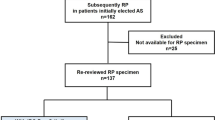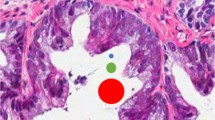Abstract
Ductal adenocarcinoma (DAC) of the prostate is thought to have worse prognosis than prostatic acinar carcinoma (PAC). We aimed to evaluate the prognostic significance of histopathological patterns of DAC. A series of 1,051 radical prostatectomy specimens from Karolinska University Hospital 1998–2005 was reviewed. A ductal component was classified as classical DAC (DACC) if it had columnar, pseudostratified epithelium, elongated nuclei, and papillary, glandular, or cribriform architecture; borderline DAC (DACB) if it lacked elongated nuclei or classical architecture; and prostatic adenocarcinoma with ductal features (PCDF) if stratified high-grade nuclei were found. DACC, DACB, and PCDF were seen in 2.6, 4.0, and 1.6 % of the cases. DAC was usually mixed with PAC and constituted 10–100 % (mean 40 %) of the main tumor. Location was periurethral, peripheral, or both in 69.8, 3.5, and 26.7 %. Necrosis was seen in 31.3 %, stromal invasion of DAC in 52.3 %, and intraductal spread in 91.9 %. In DACC/DACB and PAC, extraprostatic extension was seen in 66.7 and 42.4 % (p < 0.001) and seminal vesicle invasion in 13.0 and 5.0 % (p = 0.0045). DACC, DACB, and PCDF had a hazard ratio for biochemical recurrence of 1.5 (0.7–2.8), 1.4 (0.8–2.6) and 1.2 (0.5–2.7). When PCDF was excluded from DAC, hazard ratio was 1.4 (95 % CI 0.9–2.3, p = 0.12). Location, % DAC, necrosis, stromal invasion, or Gleason score were not predictive of recurrence. This suggests that DACC and DACB are more aggressive than average PAC, while cancers with acinar architecture and pseudostratified high-grade nuclei should not be included in DAC.



Similar content being viewed by others
References
Melicow MM, Pachter MR (1967) Endometrial carcinoma of proxtatic utricle (uterus masculinus). Cancer 20:1715–1722
Bock BJ, Bostwick DG (1999) Does prostatic ductal adenocarcinoma exist? Am J Surg Pathol 23:781–785
Gong Y, Caraway N, Stewart J, Staerkel G (2006) Metastatic ductal adenocarcinoma of the prostate: cytologic features and clinical findings. Am J Clin Pathol 126:302–309
Millar EK, Sharma NK, Lessells AM (1996) Ductal (endometrioid) adenocarcinoma of the prostate: a clinicopathological study of 16 cases. Histopathology 29:11–19
Orihuela E, Green JM (2008) Ductal prostate cancer: contemporary management and outcomes. Urol Oncol 26:368–371
Tu SM, Lopez A, Leibovici D, Bilen MA, Evliyaoglu F, Aparicio A, Guo CC, Kuban DA, Johnson MM, Pisters LL (2009) Ductal adenocarcinoma of the prostate: clinical features and implications after local therapy. Cancer 115:2872–2880
Brinker DA, Potter SR, Epstein JI (1999) Ductal adenocarcinoma of the prostate diagnosed on needle biopsy: correlation with clinical and radical prostatectomy findings and progression. Am J Surg Pathol 23:1471–1479
Morgan TM, Welty CJ, Vakar-Lopez F, Lin DW, Wright JL (2010) Ductal adenocarcinoma of the prostate: increased mortality risk and decreased serum prostate specific antigen. J Urol 184:2303–2307
Samaratunga H, Delahunt B (2008) Ductal adenocarcinoma of the prostate: current opinion and controversies. Anal Quant Cytol Histol 30:237–246
Christensen WN, Steinberg G, Walsh PC, Epstein JI (1991) Prostatic duct adenocarcinoma. Findings at radical prostatectomy. Cancer 67:2118–2124
Eble JN, Sauter G, Epstein JI (2004) Sesterhenn IA (2004) Pathology and Genetics of Tumours of the Urinary System and Male Genital Organs. IARC, Lyon
Samaratunga H, Duffy D, Yaxley J, Delahunt B (2010) Any proportion of ductal adenocarcinoma in radical prostatectomy specimens predicts extraprostatic extension. Hum Pathol 41:281–285
Jonmarker S, Glaessgen A, Culp WD, Pisa P, Lewensohn R, Ekman P, Valdman A, Egevad L (2008) Expression of PDX-1 in prostate cancer, prostatic intraepithelial neoplasia and benign prostatic tissue. APMIS 116:491–498
Dube VE, Farrow GM, Greene LF (1973) Prostatic adenocarcinoma of ductal origin. Cancer 32:402–409
Kuhajda FP, Gipson T, Mendelsohn G (1984) Papillary adenocarcinomas of the prostate. An immunohistochemical study. Cancer 54:1328–1332
Samaratunga H, Singh M (1997) Distribution pattern of basal cells detected by cytokeratin 34 beta E12 in primary prostatic duct adenocarcinoma. Am J Surg Pathol 21:435–440
Bostwick DG, Kindrachuk RW, Rouse RV (1985) Prostatic adenocarcinoma with endometrioid features. Clinical, pathologic, and ultrastructural findings. Am J Surg Pathol 9:595–609
Epstein JI, Woodruff JM (1986) Adenocarcinoma of the prostate with endometrioid features. A light microscopic and immunohistochemical study of ten cases. Cancer 57:111–119
Eade TN, Al-Saleem T, Horwitz EM, Buyyounouski MK, Chen DY, Pollack A (2007) Role of radiotherapy in ductal (endometrioid) carcinoma of the prostate. Cancer 109:2011–2015
Pickup M, Van der Kwast TH (2007) My approach to intraductal lesions of the prostate gland. J Clin Pathol 60:856–865
Lee TK, Miller JS, Epstein JI (2010) Rare histological patterns of prostatic ductal adenocarcinoma. Pathology 42:319–324
Vale JA, Patel A, Ball AJ, Hendry WF, Chappell ME, Fisher C (1992) Endometrioid carcinoma of the prostate: a misnomer? J R Soc Med 85:394–396
Epstein JI (2010) Prostatic ductal adenocarcinoma: a mini review. Med Princ Pract 19:82–85
Lee SS (1994) Endometrioid adenocarcinoma of the prostate: a clinicopathologic and immunohistochemical study. J Surg Oncol 55:235–238
Young RH, Srigley JR, Amin MB, Ulbright TM, Cubilla AL (2000) Tumors of the Prostate Gland, Seminal Vesicles, Male Urethra and Penis. Armed Forces Institute of Pathology, Washington D.C. 2000
Epstein JI, Allsbrook WC Jr, Amin MB, Egevad L (2006) Update on the Gleason grading system for prostate cancer: results of an international consensus conference of urologic pathologists. Adv Anat Pathol 13:57–59
Conflict of interest
The authors declare that they have no conflict of interest.
Author information
Authors and Affiliations
Corresponding author
Rights and permissions
About this article
Cite this article
Seipel, A.H., Wiklund, F., Wiklund, N.P. et al. Histopathological features of ductal adenocarcinoma of the prostate in 1,051 radical prostatectomy specimens. Virchows Arch 462, 429–436 (2013). https://doi.org/10.1007/s00428-013-1385-5
Received:
Revised:
Accepted:
Published:
Issue Date:
DOI: https://doi.org/10.1007/s00428-013-1385-5




